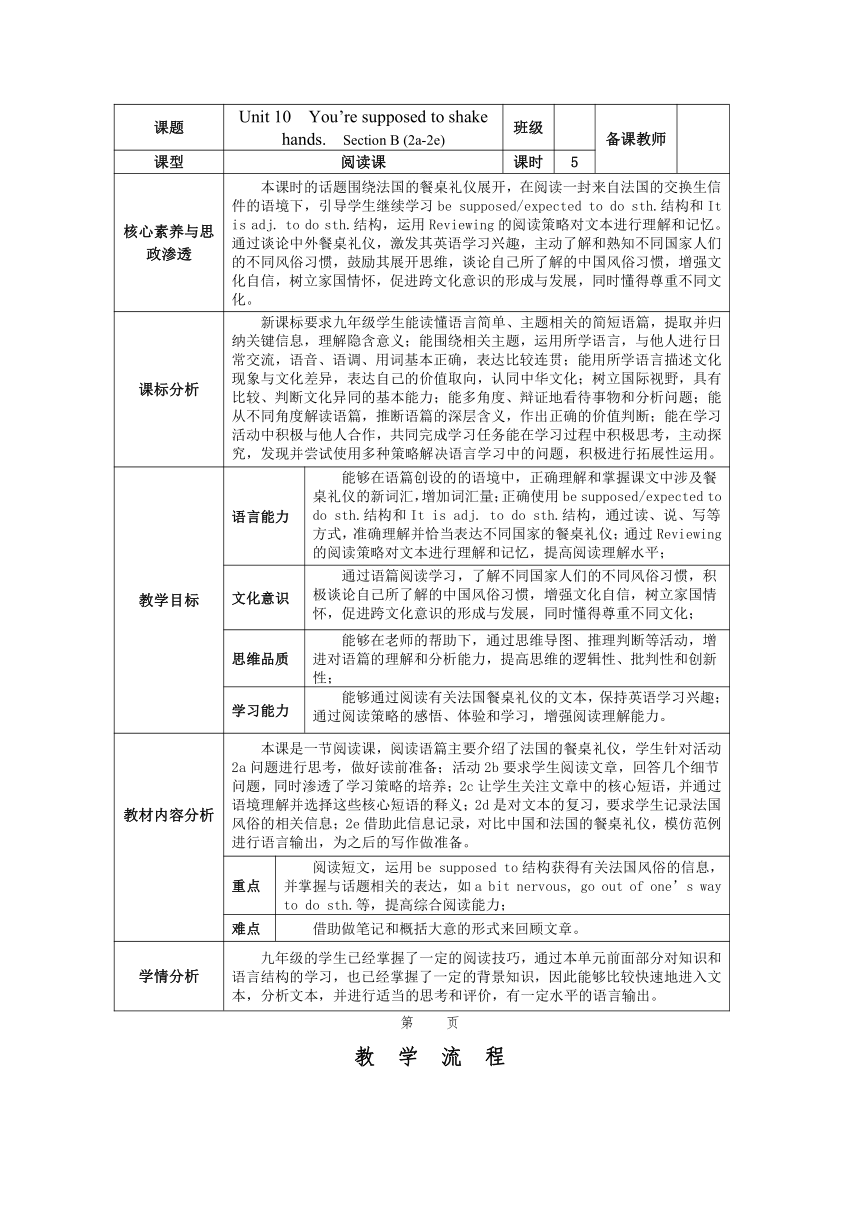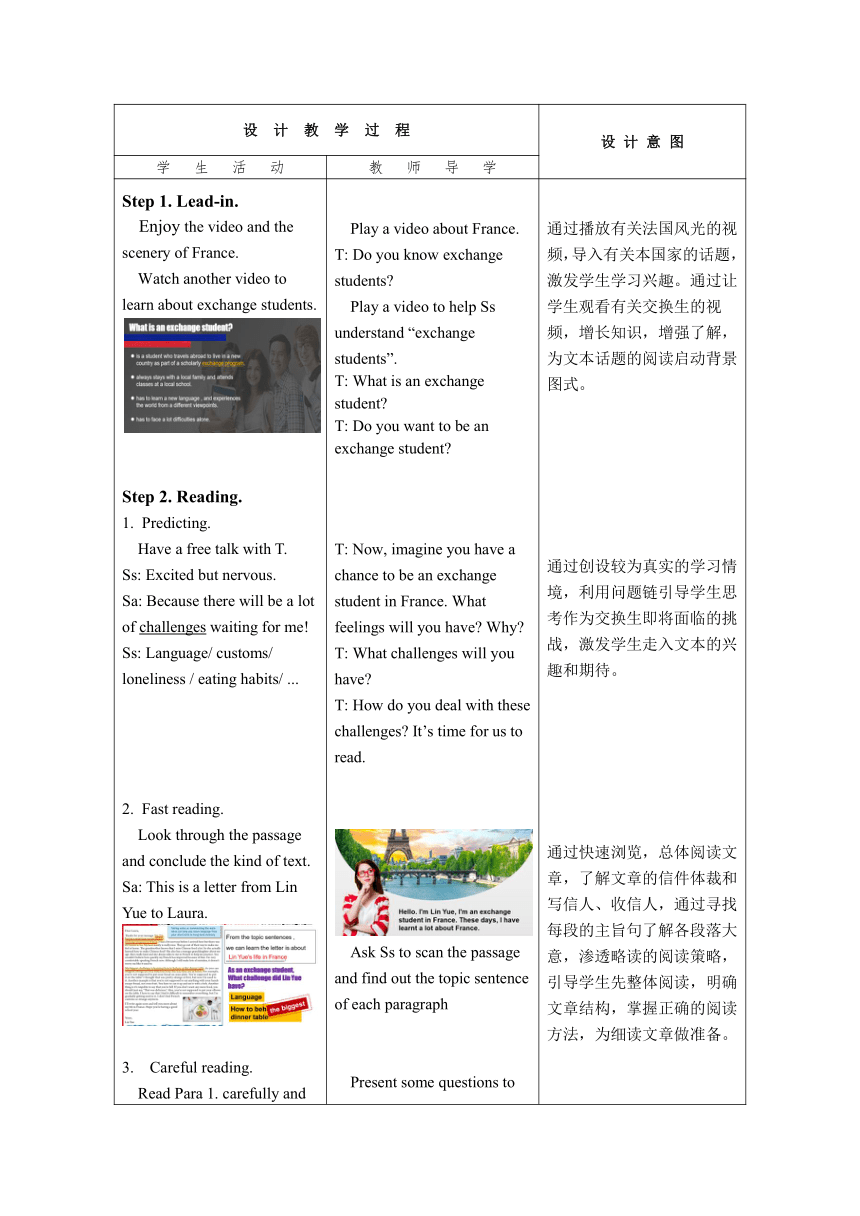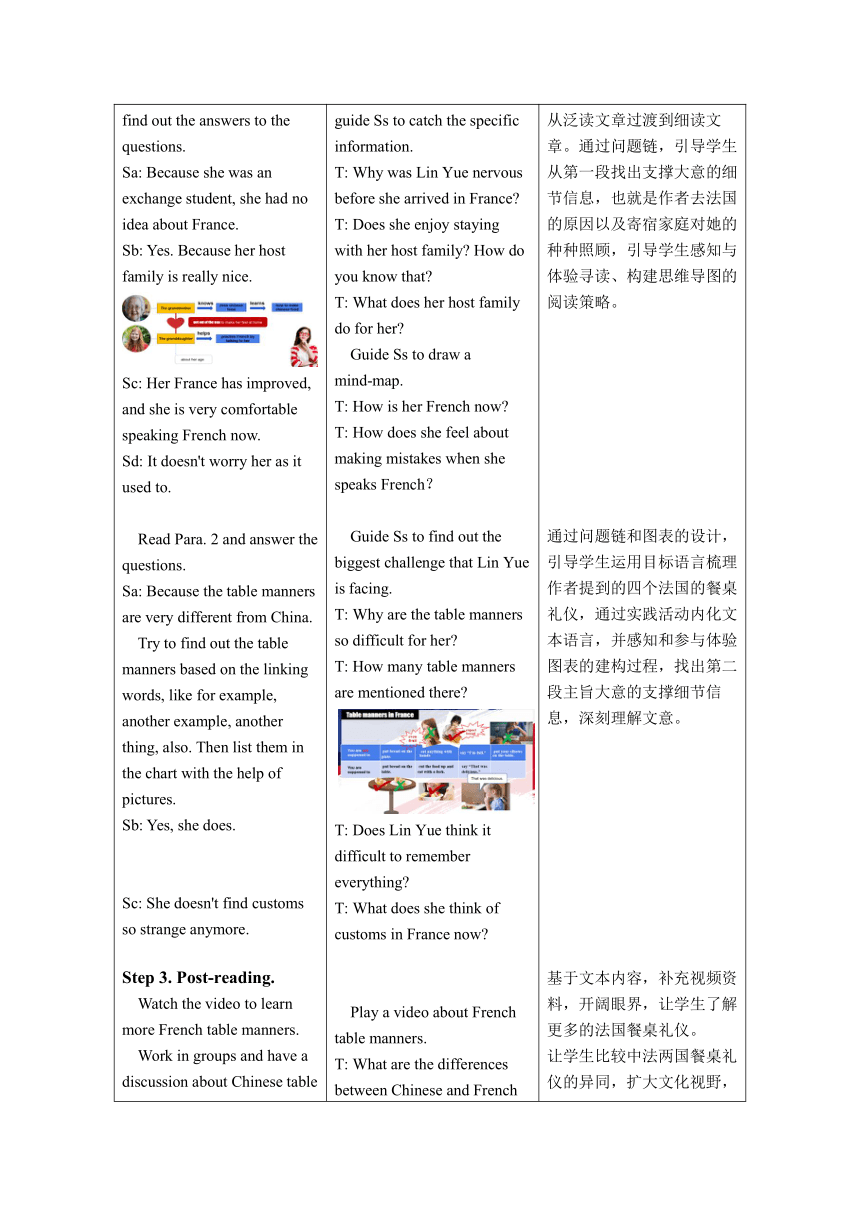【核心素养目标】Unit 10 You’re supposed to shake hands. Section B (2a-2e) 表格式教案
文档属性
| 名称 | 【核心素养目标】Unit 10 You’re supposed to shake hands. Section B (2a-2e) 表格式教案 |

|
|
| 格式 | docx | ||
| 文件大小 | 1.3MB | ||
| 资源类型 | 教案 | ||
| 版本资源 | 人教新目标(Go for it)版 | ||
| 科目 | 英语 | ||
| 更新时间 | 2024-09-24 14:54:07 | ||
图片预览



文档简介
课题 Unit 10 You’re supposed to shake hands. Section B (2a-2e) 班级 备课教师
课型 阅读课 课时 5
核心素养与思政渗透 本课时的话题围绕法国的餐桌礼仪展开,在阅读一封来自法国的交换生信件的语境下,引导学生继续学习be supposed/expected to do sth.结构和It is adj. to do sth.结构,运用Reviewing的阅读策略对文本进行理解和记忆。通过谈论中外餐桌礼仪,激发其英语学习兴趣,主动了解和熟知不同国家人们的不同风俗习惯,鼓励其展开思维,谈论自己所了解的中国风俗习惯,增强文化自信,树立家国情怀,促进跨文化意识的形成与发展,同时懂得尊重不同文化。
课标分析 新课标要求九年级学生能读懂语言简单、主题相关的简短语篇,提取并归纳关键信息,理解隐含意义;能围绕相关主题,运用所学语言,与他人进行日常交流,语音、语调、用词基本正确,表达比较连贯;能用所学语言描述文化现象与文化差异,表达自己的价值取向,认同中华文化;树立国际视野,具有比较、判断文化异同的基本能力;能多角度、辩证地看待事物和分析问题;能从不同角度解读语篇,推断语篇的深层含义,作出正确的价值判断;能在学习活动中积极与他人合作,共同完成学习任务能在学习过程中积极思考,主动探究,发现并尝试使用多种策略解决语言学习中的问题,积极进行拓展性运用。
教学目标 语言能力 能够在语篇创设的的语境中,正确理解和掌握课文中涉及餐桌礼仪的新词汇,增加词汇量;正确使用be supposed/expected to do sth.结构和It is adj. to do sth.结构,通过读、说、写等方式,准确理解并恰当表达不同国家的餐桌礼仪;通过Reviewing的阅读策略对文本进行理解和记忆,提高阅读理解水平;
文化意识 通过语篇阅读学习,了解不同国家人们的不同风俗习惯,积极谈论自己所了解的中国风俗习惯,增强文化自信,树立家国情怀,促进跨文化意识的形成与发展,同时懂得尊重不同文化;
思维品质 能够在老师的帮助下,通过思维导图、推理判断等活动,增进对语篇的理解和分析能力,提高思维的逻辑性、批判性和创新性;
学习能力 能够通过阅读有关法国餐桌礼仪的文本,保持英语学习兴趣;通过阅读策略的感悟、体验和学习,增强阅读理解能力。
教材内容分析 本课是一节阅读课,阅读语篇主要介绍了法国的餐桌礼仪,学生针对活动2a问题进行思考,做好读前准备;活动2b要求学生阅读文章,回答几个细节问题,同时渗透了学习策略的培养;2c让学生关注文章中的核心短语,并通过语境理解并选择这些核心短语的释义;2d是对文本的复习,要求学生记录法国风俗的相关信息;2e借助此信息记录,对比中国和法国的餐桌礼仪,模仿范例进行语言输出,为之后的写作做准备。
重点 阅读短文,运用be supposed to结构获得有关法国风俗的信息,并掌握与话题相关的表达,如a bit nervous, go out of one’s way to do sth.等,提高综合阅读能力;
难点 借助做笔记和概括大意的形式来回顾文章。
学情分析 九年级的学生已经掌握了一定的阅读技巧,通过本单元前面部分对知识和语言结构的学习,也已经掌握了一定的背景知识,因此能够比较快速地进入文本,分析文本,并进行适当的思考和评价,有一定水平的语言输出。
第 页
教 学 流 程
设 计 教 学 过 程 设 计 意 图
学 生 活 动 教 师 导 学
Step 1. Lead-in. Enjoy the video and the scenery of France. Watch another video to learn about exchange students. Step 2. Reading. Predicting. Have a free talk with T. Ss: Excited but nervous. Sa: Because there will be a lot of challenges waiting for me! Ss: Language/ customs/ loneliness / eating habits/ ... Fast reading. Look through the passage and conclude the kind of text. Sa: This is a letter from Lin Yue to Laura. Careful reading. Read Para 1. carefully and find out the answers to the questions. Sa: Because she was an exchange student, she had no idea about France. Sb: Yes. Because her host family is really nice. Sc: Her France has improved, and she is very comfortable speaking French now. Sd: It doesn't worry her as it used to. Read Para. 2 and answer the questions. Sa: Because the table manners are very different from China. Try to find out the table manners based on the linking words, like for example, another example, another thing, also. Then list them in the chart with the help of pictures. Sb: Yes, she does. Sc: She doesn't find customs so strange anymore. Step 3. Post-reading. Watch the video to learn more French table manners. Work in groups and have a discussion about Chinese table manners. Share their results in class. Then complete the passage about the differences between Chinese and French table manners. Step 4. Conclusion. Listen to T to explain the language points. Then do some exercises. Play a video about France. T: Do you know exchange students Play a video to help Ss understand “exchange students”. T: What is an exchange student T: Do you want to be an exchange student T: Now, imagine you have a chance to be an exchange student in France. What feelings will you have Why T: What challenges will you have T: How do you deal with these challenges It’s time for us to read. Ask Ss to scan the passage and find out the topic sentence of each paragraph Present some questions to guide Ss to catch the specific information. T: Why was Lin Yue nervous before she arrived in France T: Does she enjoy staying with her host family How do you know that T: What does her host family do for her Guide Ss to draw a mind-map. T: How is her French now T: How does she feel about making mistakes when she speaks French? Guide Ss to find out the biggest challenge that Lin Yue is facing. T: Why are the table manners so difficult for her T: How many table manners are mentioned there T: Does Lin Yue think it difficult to remember everything T: What does she think of customs in France now Play a video about French table manners. T: What are the differences between Chinese and French table manners T: How much do you know about Chinese table manners What are we supposed to do What are we supposed not to do Ask Ss to finish 2c & 2d. T: What is the best table manners? 通过播放有关法国风光的视频,导入有关本国家的话题,激发学生学习兴趣。通过让学生观看有关交换生的视频,增长知识,增强了解,为文本话题的阅读启动背景图式。 通过创设较为真实的学习情境,利用问题链引导学生思考作为交换生即将面临的挑战,激发学生走入文本的兴趣和期待。 通过快速浏览,总体阅读文章,了解文章的信件体裁和写信人、收信人,通过寻找每段的主旨句了解各段落大意,渗透略读的阅读策略,引导学生先整体阅读,明确文章结构,掌握正确的阅读方法,为细读文章做准备。 从泛读文章过渡到细读文章。通过问题链,引导学生从第一段找出支撑大意的细节信息,也就是作者去法国的原因以及寄宿家庭对她的种种照顾,引导学生感知与体验寻读、构建思维导图的阅读策略。 通过问题链和图表的设计,引导学生运用目标语言梳理作者提到的四个法国的餐桌礼仪,通过实践活动内化文本语言,并感知和参与体验图表的建构过程,找出第二段主旨大意的支撑细节信息,深刻理解文意。 基于文本内容,补充视频资料,开阔眼界,让学生了解更多的法国餐桌礼仪。 让学生比较中法两国餐桌礼仪的异同,扩大文化视野,增强跨文化交际的意识。 通过创新文本的完成,引导学生整合文章主要信息并联系自身实际进行再创造,再次检查学生对文章细节的获取、理解和复述,巩固语言知识,帮助学生梳理文章内容,提升逻辑、创新思维,并将所学到的语言知识进行内化和创造性输出。 渗透情感态度价值观教育,懂得具备包容态度,尊重不同文化。
第 页
课 时 达 标 检 测
Ⅰ. 根据句意及汉语提示完成句子。 1.Drums are (基础的) to African music. People there play them often. 2.Yesterday afternoon, everybody in our class went to the art museum (除了) Mike. 3.This lovely girl is Mr. King's (外孙女). They are playing in the garden. 4.His children study hard and (表现) well at school. 5.Mike sat with his right (肘) on the table. Ⅱ. 用所给单词的适当形式填空 6.The two old classmates were both excited to meet each other and (exchange) addresses and phone numbers. 7.It's rude to eat while (walk) down the street. 8.They (actual) solved the problem in a different way. 9.The magazine is good for (teenager) because most of its articles are educational. 10.I wasn't used to going to bed early before, but I'm (gradual) getting used to it now. Ⅲ. 词语运用,有两个词为多余项。 Japan, polite, popular, rule, eat, exciting, manner, drink, direct, stick, if, prevent
Visitors to Japan are often 1. about the delicious food, but many people are a little nervous about what to do at restaurants or in a Japanese household. So it's helpful to know basic table 2. before going to Japan. 3. people use knives, forks, spoons and chopsticks to eat. But chopsticks are the most 4. utensils(用具). When you are eating dinner with some Japanese friends, don't 5. pass food from your chopsticks to somebody else's chopsticks. It's also important not to 6. chopsticks vertically(垂直地) into food, especially into a bowl of rice. It's 7. to move your chopsticks up and down above dishes or to point at somebody with your chopsticks. It is polite to lift small bowls of rice or soup when you eat. It 8. you from dropping food. In Japan, it is common to slurp(发出啧啧声) while 9. noodles. People say the noodles taste better 10. they make slurping noises.
第 页
课 时 教 学 设 计 尾 页
板 书 设 计
Unit 10 You’re supposed to shake hands. Section B (2a-2e)
作 业 设 计
Level A Write a letter to your French pen pal who is coming to China as an exchange student. Introduce the table manners in China to help him or her.
Level B Draw a mind-map about the table manners in France according to the letter.
教 学 反 思
第 页
课型 阅读课 课时 5
核心素养与思政渗透 本课时的话题围绕法国的餐桌礼仪展开,在阅读一封来自法国的交换生信件的语境下,引导学生继续学习be supposed/expected to do sth.结构和It is adj. to do sth.结构,运用Reviewing的阅读策略对文本进行理解和记忆。通过谈论中外餐桌礼仪,激发其英语学习兴趣,主动了解和熟知不同国家人们的不同风俗习惯,鼓励其展开思维,谈论自己所了解的中国风俗习惯,增强文化自信,树立家国情怀,促进跨文化意识的形成与发展,同时懂得尊重不同文化。
课标分析 新课标要求九年级学生能读懂语言简单、主题相关的简短语篇,提取并归纳关键信息,理解隐含意义;能围绕相关主题,运用所学语言,与他人进行日常交流,语音、语调、用词基本正确,表达比较连贯;能用所学语言描述文化现象与文化差异,表达自己的价值取向,认同中华文化;树立国际视野,具有比较、判断文化异同的基本能力;能多角度、辩证地看待事物和分析问题;能从不同角度解读语篇,推断语篇的深层含义,作出正确的价值判断;能在学习活动中积极与他人合作,共同完成学习任务能在学习过程中积极思考,主动探究,发现并尝试使用多种策略解决语言学习中的问题,积极进行拓展性运用。
教学目标 语言能力 能够在语篇创设的的语境中,正确理解和掌握课文中涉及餐桌礼仪的新词汇,增加词汇量;正确使用be supposed/expected to do sth.结构和It is adj. to do sth.结构,通过读、说、写等方式,准确理解并恰当表达不同国家的餐桌礼仪;通过Reviewing的阅读策略对文本进行理解和记忆,提高阅读理解水平;
文化意识 通过语篇阅读学习,了解不同国家人们的不同风俗习惯,积极谈论自己所了解的中国风俗习惯,增强文化自信,树立家国情怀,促进跨文化意识的形成与发展,同时懂得尊重不同文化;
思维品质 能够在老师的帮助下,通过思维导图、推理判断等活动,增进对语篇的理解和分析能力,提高思维的逻辑性、批判性和创新性;
学习能力 能够通过阅读有关法国餐桌礼仪的文本,保持英语学习兴趣;通过阅读策略的感悟、体验和学习,增强阅读理解能力。
教材内容分析 本课是一节阅读课,阅读语篇主要介绍了法国的餐桌礼仪,学生针对活动2a问题进行思考,做好读前准备;活动2b要求学生阅读文章,回答几个细节问题,同时渗透了学习策略的培养;2c让学生关注文章中的核心短语,并通过语境理解并选择这些核心短语的释义;2d是对文本的复习,要求学生记录法国风俗的相关信息;2e借助此信息记录,对比中国和法国的餐桌礼仪,模仿范例进行语言输出,为之后的写作做准备。
重点 阅读短文,运用be supposed to结构获得有关法国风俗的信息,并掌握与话题相关的表达,如a bit nervous, go out of one’s way to do sth.等,提高综合阅读能力;
难点 借助做笔记和概括大意的形式来回顾文章。
学情分析 九年级的学生已经掌握了一定的阅读技巧,通过本单元前面部分对知识和语言结构的学习,也已经掌握了一定的背景知识,因此能够比较快速地进入文本,分析文本,并进行适当的思考和评价,有一定水平的语言输出。
第 页
教 学 流 程
设 计 教 学 过 程 设 计 意 图
学 生 活 动 教 师 导 学
Step 1. Lead-in. Enjoy the video and the scenery of France. Watch another video to learn about exchange students. Step 2. Reading. Predicting. Have a free talk with T. Ss: Excited but nervous. Sa: Because there will be a lot of challenges waiting for me! Ss: Language/ customs/ loneliness / eating habits/ ... Fast reading. Look through the passage and conclude the kind of text. Sa: This is a letter from Lin Yue to Laura. Careful reading. Read Para 1. carefully and find out the answers to the questions. Sa: Because she was an exchange student, she had no idea about France. Sb: Yes. Because her host family is really nice. Sc: Her France has improved, and she is very comfortable speaking French now. Sd: It doesn't worry her as it used to. Read Para. 2 and answer the questions. Sa: Because the table manners are very different from China. Try to find out the table manners based on the linking words, like for example, another example, another thing, also. Then list them in the chart with the help of pictures. Sb: Yes, she does. Sc: She doesn't find customs so strange anymore. Step 3. Post-reading. Watch the video to learn more French table manners. Work in groups and have a discussion about Chinese table manners. Share their results in class. Then complete the passage about the differences between Chinese and French table manners. Step 4. Conclusion. Listen to T to explain the language points. Then do some exercises. Play a video about France. T: Do you know exchange students Play a video to help Ss understand “exchange students”. T: What is an exchange student T: Do you want to be an exchange student T: Now, imagine you have a chance to be an exchange student in France. What feelings will you have Why T: What challenges will you have T: How do you deal with these challenges It’s time for us to read. Ask Ss to scan the passage and find out the topic sentence of each paragraph Present some questions to guide Ss to catch the specific information. T: Why was Lin Yue nervous before she arrived in France T: Does she enjoy staying with her host family How do you know that T: What does her host family do for her Guide Ss to draw a mind-map. T: How is her French now T: How does she feel about making mistakes when she speaks French? Guide Ss to find out the biggest challenge that Lin Yue is facing. T: Why are the table manners so difficult for her T: How many table manners are mentioned there T: Does Lin Yue think it difficult to remember everything T: What does she think of customs in France now Play a video about French table manners. T: What are the differences between Chinese and French table manners T: How much do you know about Chinese table manners What are we supposed to do What are we supposed not to do Ask Ss to finish 2c & 2d. T: What is the best table manners? 通过播放有关法国风光的视频,导入有关本国家的话题,激发学生学习兴趣。通过让学生观看有关交换生的视频,增长知识,增强了解,为文本话题的阅读启动背景图式。 通过创设较为真实的学习情境,利用问题链引导学生思考作为交换生即将面临的挑战,激发学生走入文本的兴趣和期待。 通过快速浏览,总体阅读文章,了解文章的信件体裁和写信人、收信人,通过寻找每段的主旨句了解各段落大意,渗透略读的阅读策略,引导学生先整体阅读,明确文章结构,掌握正确的阅读方法,为细读文章做准备。 从泛读文章过渡到细读文章。通过问题链,引导学生从第一段找出支撑大意的细节信息,也就是作者去法国的原因以及寄宿家庭对她的种种照顾,引导学生感知与体验寻读、构建思维导图的阅读策略。 通过问题链和图表的设计,引导学生运用目标语言梳理作者提到的四个法国的餐桌礼仪,通过实践活动内化文本语言,并感知和参与体验图表的建构过程,找出第二段主旨大意的支撑细节信息,深刻理解文意。 基于文本内容,补充视频资料,开阔眼界,让学生了解更多的法国餐桌礼仪。 让学生比较中法两国餐桌礼仪的异同,扩大文化视野,增强跨文化交际的意识。 通过创新文本的完成,引导学生整合文章主要信息并联系自身实际进行再创造,再次检查学生对文章细节的获取、理解和复述,巩固语言知识,帮助学生梳理文章内容,提升逻辑、创新思维,并将所学到的语言知识进行内化和创造性输出。 渗透情感态度价值观教育,懂得具备包容态度,尊重不同文化。
第 页
课 时 达 标 检 测
Ⅰ. 根据句意及汉语提示完成句子。 1.Drums are (基础的) to African music. People there play them often. 2.Yesterday afternoon, everybody in our class went to the art museum (除了) Mike. 3.This lovely girl is Mr. King's (外孙女). They are playing in the garden. 4.His children study hard and (表现) well at school. 5.Mike sat with his right (肘) on the table. Ⅱ. 用所给单词的适当形式填空 6.The two old classmates were both excited to meet each other and (exchange) addresses and phone numbers. 7.It's rude to eat while (walk) down the street. 8.They (actual) solved the problem in a different way. 9.The magazine is good for (teenager) because most of its articles are educational. 10.I wasn't used to going to bed early before, but I'm (gradual) getting used to it now. Ⅲ. 词语运用,有两个词为多余项。 Japan, polite, popular, rule, eat, exciting, manner, drink, direct, stick, if, prevent
Visitors to Japan are often 1. about the delicious food, but many people are a little nervous about what to do at restaurants or in a Japanese household. So it's helpful to know basic table 2. before going to Japan. 3. people use knives, forks, spoons and chopsticks to eat. But chopsticks are the most 4. utensils(用具). When you are eating dinner with some Japanese friends, don't 5. pass food from your chopsticks to somebody else's chopsticks. It's also important not to 6. chopsticks vertically(垂直地) into food, especially into a bowl of rice. It's 7. to move your chopsticks up and down above dishes or to point at somebody with your chopsticks. It is polite to lift small bowls of rice or soup when you eat. It 8. you from dropping food. In Japan, it is common to slurp(发出啧啧声) while 9. noodles. People say the noodles taste better 10. they make slurping noises.
第 页
课 时 教 学 设 计 尾 页
板 书 设 计
Unit 10 You’re supposed to shake hands. Section B (2a-2e)
作 业 设 计
Level A Write a letter to your French pen pal who is coming to China as an exchange student. Introduce the table manners in China to help him or her.
Level B Draw a mind-map about the table manners in France according to the letter.
教 学 反 思
第 页
同课章节目录
- Unit 1 How can we become good learners.
- Section A
- Section B
- Unit 2 I think that mooncakes are delicious!
- Section A
- Section B
- Unit 3 Could you please tell me where the restroom
- Section A
- Section B
- Unit 4 I used to be afraid of the dark.
- Section A
- Section B
- Unit 5 What are the shirts made of?
- Section A
- Section B
- Review of Units 1-5
- Unit 6 When was it invented?
- Section A
- Section B
- Unit 7 Teenagers should be allowed to choose their
- Section A
- Section B
- Unit 8 It must belong to Carla.
- Section A
- Section B
- Unit 9 I like music that I can dance to.
- Section A
- Section B
- Unit 10 You're supposed to shake hands.
- Section A
- Section B
- Review of Units 6-10
- Unit 11 Sad movies make me cry.
- Section A
- Section B
- Unit 12 Life is full of the unexpected
- Section A
- Section B
- Unit 13 We're trying to save the earth!
- Section A
- Section B
- Unit 14 I remember meeting all of you in Grade 7.
- Section A
- Section B
- Review of Units 11-14
